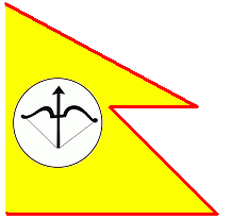 zachary harden
zachary harden
Keywords: nepal | kirat autonomous state |
Links: FOTW homepage | search | disclaimer and copyright | write us | mirrors

Last modified: 2023-06-03 by  zachary harden
zachary harden
Keywords: nepal | kirat autonomous state |
Links: FOTW homepage |
search |
disclaimer and copyright |
write us |
mirrors
 image by Chrystian Kretowicz, 17 January 2010
image by Chrystian Kretowicz, 17 January 2010See also:
In December last year the Maoists declared, among others, the Kirat (Kirant)
Autonomous State out of the districts: Solukhumbu, Sankhuwasabha, Okhaldhunga,
Khotang, Bhojpur and Udayapur. There is no mention of its flag, but there is a
"national" flag of the Kirati people which, as some claim, represented the
Kirat-Desh (Kirat Country) in the very ancient War of Kurukshetra, described in
the Hindu epic of Mahabharata and dated sometime between 5561 BC to 800 BC. If
so, it predates, by a long shot, the Dannebrog. It is also claimed, the Kirat
flag served as a model for the Nepali flag and some are suggesting it should be
adopted as the new national flag for Nepal.
Wikipedia says about Kirati
people:
"Kirat-or Kirati- means people with lion nature. It is derived from
two words Kira-Lion and Ti- people and it also means people from the mountain.
They are indigenous ethnic Kirati group of Nepal. It includes the Limbu, Rai,
Yakkha and Sunuwar ethnic groups. The Kirat were the earliest inhabitants of the
Kathmandu Valley. Dhimal, Hayu, Koch, Thami, Tharu, Chepang, and Surel ethnic
groups also consider themselves to be of Kirati descent."
http://en.wikipedia.org/wiki/Kirat
The flag can be seen at:
http://www.youtube.com/watch?v=2aYh6zSSdcQ (0:15) and at many other websites
of the Kirati organizations.
By no means I'm claiming it is the oldest
flag in the world. It's just a suggestion derived from the postings on several
Nepali forums.
Chrystian Kretowicz, 17 January 2010
Historical significance behind the
design of Nepal flag
In the ancient War of Kurukshetra, described in the
Hindu epic of Mahabharata dating back to some 800 BC, there is mentioned that
Yalambar, the first King of Nepal took part part in this great war. There is no
mention of its flag, but there is a national flag of the Kirati people which, as
some claim, represented Nepal in this great war. It is also claimed, the Kirat
flag served as a model for the Nepali flag and some are suggesting it should be
adopted as the new national flag for Nepal.
The
origin of the unique double triangle of Kirat flag symbolizes the Kirat and
Nepal during vedic age(1500BC - 600BC). That's how the Nepal flag is believed to
have derive from as some scholars have uncovered the secret now.
Here's
the brief insight into Kirat flag. There are three significant meanings in the
Kirat flag.